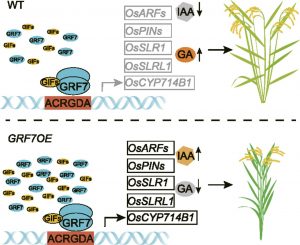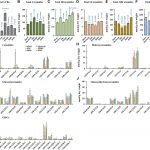A Molecular Determinant of Rice Plant Architecture
 Plant architecture is a major determinant of rice (Oryza sativa) productivity. Rice plant architecture is mainly defined by plant height, the spatial pattern of leaves, and tiller and inflorescence branching patterns. Plant height and tiller branching determine the biomass and harvest index, while the spatial pattern of leaves, including leaf shape and angle, influences the photosynthesis rate and therefore the accumulation of carbohydrates. GROWTH-REGULATING FACTORs (GRFs), proteins specific to plants, participate in reproductive and vegetative development, senescence. and stress tolerance. In rice (Oryza sativa), there are 12 GRFs, but the role of the miR396-OsGRF7 regulatory module remains unknown. Chen et al. (10.1104/pp.20.00302) now report that OsGRF7 shapes rice plant architecture via the regulation of auxin and GA metabolism. OsGRF7 is mainly expressed in lamina joints, nodes, internodes, axillary buds, and young inflorescences. The overexpression of OsGRF7 causes a semi-dwarf and compact plant architecture with an increased culm wall thickness and narrowed leaf angles mediated by shortened cell length, altered cell arrangement, and increased parenchymal cell layers in the culm and adaxial side of the lamina joints. Knockout and knockdown lines of OsGRF7 exhibit contrasting phenotypes with severe degradation of parenchymal cells in the culm and lamina joints at maturity. Further analysis indicated that OsGRF7 binds a specific motif in the promoters of a cytochrome P450 gene and AUXIN RESPONSE FACTOR12, which are involved in the GA synthesis and auxin signaling pathways, respectively. Correspondingly, OsGRF7 alters the contents of endogenous GAs and auxins and sensitivity to exogenous phytohormones. This study demonstrates that OsGRF7 is a key regulator of the shaping of plant architecture through its effects on GA and IAA signaling networks.
Plant architecture is a major determinant of rice (Oryza sativa) productivity. Rice plant architecture is mainly defined by plant height, the spatial pattern of leaves, and tiller and inflorescence branching patterns. Plant height and tiller branching determine the biomass and harvest index, while the spatial pattern of leaves, including leaf shape and angle, influences the photosynthesis rate and therefore the accumulation of carbohydrates. GROWTH-REGULATING FACTORs (GRFs), proteins specific to plants, participate in reproductive and vegetative development, senescence. and stress tolerance. In rice (Oryza sativa), there are 12 GRFs, but the role of the miR396-OsGRF7 regulatory module remains unknown. Chen et al. (10.1104/pp.20.00302) now report that OsGRF7 shapes rice plant architecture via the regulation of auxin and GA metabolism. OsGRF7 is mainly expressed in lamina joints, nodes, internodes, axillary buds, and young inflorescences. The overexpression of OsGRF7 causes a semi-dwarf and compact plant architecture with an increased culm wall thickness and narrowed leaf angles mediated by shortened cell length, altered cell arrangement, and increased parenchymal cell layers in the culm and adaxial side of the lamina joints. Knockout and knockdown lines of OsGRF7 exhibit contrasting phenotypes with severe degradation of parenchymal cells in the culm and lamina joints at maturity. Further analysis indicated that OsGRF7 binds a specific motif in the promoters of a cytochrome P450 gene and AUXIN RESPONSE FACTOR12, which are involved in the GA synthesis and auxin signaling pathways, respectively. Correspondingly, OsGRF7 alters the contents of endogenous GAs and auxins and sensitivity to exogenous phytohormones. This study demonstrates that OsGRF7 is a key regulator of the shaping of plant architecture through its effects on GA and IAA signaling networks.



